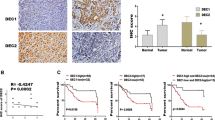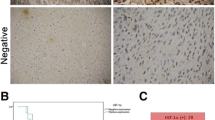Abstract
Overexpression of differentiated embryo chondrocyte 1 (DEC1) has been reported to contribute to the cellular differentiation, proliferation, and apoptosis of various cancers. Our previous studies have shown that DEC1 was highly expressed in gastric cancer (GCa) tissues. However, there is no report about the expression of DEC1 in GCa cell lines until now. In this study, We evaluated the mRNA and protein expression of DEC1 and hypoxia-inducible factor 1α (HIF-1α) under normoxic and hypoxic conditions in six GCa cell lines: BGC-823, MGC80-3, MKN1, AGS, FU97 and SGC-7901. An HIF-1α protein inhibitor was used to analyze the association of DEC1 and HIF-1α expression. Under normoxia, the mRNA expression of both HIF-1α and DEC1 was moderate, whereas the protein expression of DEC1 was higher than that of HIF-1α. Hypoxia induced the mRNA expression of DEC1 and the protein expression of HIF-1α and DEC1 in a time-dependent manner but had no effect on the mRNA expression of HIF-1α. Furthermore, inhibition of HIF-1α protein expression resulted in a significant decrease in both the mRNA and protein expression of DEC1. Taken together, DEC1 expression is correlated with HIF-1α protein in GCa cell line, blockage of HIF-1α protein led to reduced DEC1 expression. The efficacy of inhibiting HIF-1α and DEC1 expression should be tested in clinical trials as possible treatment for GCa.






Similar content being viewed by others
References
Ivan M, Kondo K, Yang H et al (2005) HIF-α targeted for VHL-mediated destruction by proline hydroxylation: Implications for O2 sensing. Science 292:464–468. doi:10.1126/science.1059817
Wykoff CC, Pugh CW, Maxwell PH, Harris AL, Ratcliffe PJ (2000) Identification of novel hypoxia dependent and independent target genes of the von Hippel–Lindau (VHL) tumour suppressor by mRNA differential expression profiling. Oncogene 19:6297–6305. doi:10.1038/sj.onc.1204012
Kitamuro T, Takahashi K, Nakayama M et al (2000) Induction of adrenomedullin during hypoxia in cultured human glioblastoma cells. J Neurochem 75:1826–1833. doi:10.1046/j.1471-4159.2000.0751826.x
Chakrabarti J, Turley H, Campo L et al (2004) The transcription factor DEC1 (stra13, SHARP2) is associated with the hypoxic response and high tumour grade in human breast cancers. Br J Cancer 91:954–958. doi:10.1038/sj.bjc.6602059
Miyazaki K, Kawamoto T, Tanimoto K et al (2002) Identification of functional hypoxia response elements in the promoter region of the DEC1 and DEC2 genes. J Biol Chem 277:47014–47021. doi:10.1074/jbc.M204938200
Zhong H, De Marzo AM, Laughner E et al (1999) Overexpression of hypoxia-inducible factor 1alpha in common human cancers and their metastases. Cancer Res 59:5830–5835
Mizokami K, Kakeji Y, Oda S, Maehara Y (2006) Relationship of hypoxia-inducible factor 1alpha and p21WAF1/CIP1 expression to cell apoptosis and clinical outcome in patients with gastric cancer. World J Surg Oncol 4:94. doi:10.1186/1477-7819-4-94
Sumiyoshi Y, Kakeji Y, Egashira A et al (2006) Overexpression of hypoxia-inducible factor 1alpha and p53 is a marker for an unfavorable prognosis in gastric cancer. Clin Cancer Res 12:5112–5117. doi:10.1158/1078-0432.CCR-05-2382
Urano N, Fujiwara Y, Doki Y et al (2006) Overexpression of hypoxia-inducible factor-1 alpha in gastric adenocarcinoma. Gastric Cancer 9:44–49. doi:10.1007/s10120-005-0356-1
Mizokami K, Kakeji Y, Oda S, Irie K et al (2006) Clinicopathologic significance of hypoxia-inducible factor 1alpha overexpression in gastric carcinomas. J Surg Oncol 94:149–154. doi:10.1002/jso.20568
Oh SY, Kwon HC, Kim SH et al (2008) Clinicopathologic significance of HIF-1alpha, p53, and VEGF expression and preoperative serum VEGF level in gastric cancer. BMC Cancer 8:123. doi:10.1186/1471-2407-8-123
Kolev Y, Uetake H, Takagi Y, Sugihara K (2008) Lactate dehydrogenase-5 (LDH-5) expression in human gastric cancer: Association with hypoxia-inducible factor (HIF-1alpha) pathway, angiogenic factors production and poor prognosis. Ann Surg Oncol 15:2336–2344. doi:10.1245/s10434-008-9955-5
Stoeltzing O, McCarty MF, Wey JS et al (2004) Role of hypoxia-inducible factor 1alpha in gastric cancer cell growth, angiogenesis, and vessel maturation. J Natl Cancer Inst 96:946–956. doi:10.1093/jnci/djh168
Lee BL, Kim WH, Jung J et al (2008) A hypoxia-independent up-regulation of hypoxia-inducible factor-1 by AKT contributes to angiogenesis in human gastric cancer. Carcinogenesis 29:44–51. doi:10.1093/carcin/bgm232
Song IS, Wang AG, Yoon SY et al (2009) Regulation of glucose metabolism-related genes and VEGF by HIF-1alpha and HIF-1beta, but not HIF-2alpha, in gastric cancer. Exp Mol Med 41:51–58. doi:10.3858/emm.2009.41.1.007
Rohwer N, Lobitz S, Daskalow K et al (2009) HIF-1alpha determines the metastatic potential of gastric cancer cells. Br J Cancer 100:772–781. doi:10.1038/sj.bjc.6604919
Park JH, Kim TY, Jong HS et al (2003) Gastric epithelial reactive oxygen species prevent normoxic degradation of hypoxia-inducible factor-1alpha in gastric cancer cells. Clin Cancer Res 9:433–440
Ardyanto TD, Osaki M, Tokuyasu N, Nagahama Y, Ito H (2006) CoCl2-induced HIF-1alpha expression correlates with proliferation and apoptosis in MKN-1 cells: A possible role for the PI3 K/Akt pathway. Int J Oncol 29:549–555
Xing Fu Cai, Xuejun Jin, Dongho Lee et al (2006) Phenanthroquinolizidine alkaloids from the roots of boehmeria pannosa potently inhibit hypoxia-inducible factor-1 in AGS human gastric cancer cells. J Nat Prod 69:1095–1097. doi:10.1021/np060081y
Liu L, Ning X, Sun L et al (2008) Hypoxia-inducible factor-1 alpha contributes to hypoxia-induced chemoresistance in gastric cancer. Cancer Sci 99:121–128
Lin MT, Kuo IH, Chang CC et al (2008) Involvement of hypoxia-inducing factor-1alpha-dependent plasminogen activator inhibitor-1 up-regulation in Cyr61/CCN1-induced gastric cancer cell invasion. J Biol Chem 283:15807–15815. doi:10.1074/jbc.M708933200
Ardyanto TD, Osaki M, Nagahama Y et al (2008) Down-regulation of cobalt-induced HIF-1alpha expression correlates with cell proliferation and apoptosis in human gastric carcinoma cells. Oncol Rep 19:339–343
Rohwer N, Welzel M, Daskalow K et al (2008) Hypoxia-inducible factor 1alpha mediates anoikis resistance via suppression of alpha5 integrin. Cancer Res 68:10113–10120. doi:10.1158/0008-5472.CAN-08-1839
Liu L, Sun L, Zhang H et al (2009) Hypoxia-mediated up-regulation of MGr1-Ag/37LRP in gastric cancers occurs via hypoxia-inducible-factor 1-dependent mechanism and contributes to drug resistance. Int J Cancer 124:1707–1715. doi:10.1002/ijc.24135
St-Pierre B, Flock G, Zacksenhaus E, Egan SE (2002) Stra13 homodimers repress transcription through class B E-box elements. J Biol Chem 277:46544–46551. doi:10.1074/jbc.M111652200
Honma S, Kawamoto T, Takagi Y et al (2002) DEC1 and DEC2 are regulators of the mammalian molecular clock. Nature 419:841–844. doi:10.1038/nature01123
Zawel L, Yu J, Torrance CJ et al (2002) DEC1 is a downstream target of TGF-beta with sequence-specific transcriptional repressor activities. Proc Natl Acad Sci USA 99:2848–2853. doi:10.1073/pnas.261714999
Li Y, Xie M, Song X et al (2003) DEC1 negatively regulates the expression of DEC2 through binding to the E-box in the proximal promoter. J Biol Chem 278:16899–16907. doi:10.1074/jbc.M300596200
Li Y, Bi Z, Yan B, Wan Y (2006) UVB radiation induces expression of HIF-1alpha and VEGF through the EGFR/PI3 K/DEC1 pathway. Int J Mol Med 18:713–719
Ehata S, Hanyu A, Hayashi M et al (2007) Transforming growth factor-beta promotes survival of mammary carcinoma cells through induction of antiapoptotic transcription factor DEC1. Cancer Res 67:9694–9703. doi:10.1158/0008-5472.CAN-07-1522
Sato F, Bhawal UK, Kawamoto T et al (2008) Basic-helix–loop–helix (bHLH) transcription factor DEC2 negatively regulates vascular endothelial growth factor expression. Genes Cells 13:131–144. doi:10.1111/j.1365-2443.2007.01153.x
Nakamura H, Tanimoto K, Hiyama K et al (2008) Human mismatch repair gene, MLH1, is transcriptionally repressed by the hypoxia-inducible transcription factors, DEC1 and DEC2. Oncogene 27:4200–4209. doi:10.1038/onc.2008.58
Qian Y, Chen X (2008) ID1, inhibitor of differentiation/DNA binding, is an effector of the p53-dependent DNA damage response pathway. J Biol Chem 283:22410–22416. doi:10.1074/jbc.M800643200
Pedersen M, Löfstedt T, Sun J et al (2008) Stem cell factor induces HIF-1alpha at normoxia in hematopoietic cells. Biochem Biophys Res Commun 377:98–103. doi:10.1016/j.bbrc.2008.09.102
Choi SM, Cho HJ, Cho H et al (2008) Stra13/DEC1 and DEC2 inhibit sterol regulatory element binding protein-1c in a hypoxia-inducible factor-dependent mechanism. Nucleic Acids Res 36:6372–6385. doi:10.1093/nar/gkn620
Qian Y, Zhang J, Yan B, Chen X (2008) DEC1, a basic-helix–loop–helix transcription factor and a novel target gene of the p53 family, mediates p53-dependent premature senescence. Biol Chem 283:2896–2905
Zheng Y, Jia Y, Wang Y et al (2009) The hypoxia-regulated transcription factor DEC1 (Stra13, SHARP-2) and its expression in gastric cancer. OMICS 13:301–306. doi:10.1089/omi.2009.0014
Li Y, Zhang H, Xie M et al (2002) Abundant expression of DEC1/stra13/sharp2 in colon carcinoma: Its antagonizing role in serum deprivation-induced apoptosis and selective inhibition of procaspase activation. Biochem J 367:413–422. doi:10.1042/BJ20020514
Giatromanolaki A, Koukourakis MI, Sivridis E et al (2003) DEC1 (STRA13) protein expression relates to hypoxia-inducible factor 1-alpha and carbonic anhydrase-9 overexpression in non-small cell lung cancer. J Pathol 200:222–228. doi:10.1002/path.1330
Turley H, Wykoff CC, Troup S et al (2004) The hypoxia-regulated transcription factor DEC1 (Stra13, SHARP-2) and its expression in human tissues and tumours. J Pathol 203:808–813. doi:10.1002/path.1585
Currie MJ, Hanrahan V, Gunningham SP et al (2004) Expression of vascular endothelial growth factor D is associated with hypoxia inducible factor (HIF-1alpha) and the HIF-1alpha target gene DEC1, but not lymph node metastasis in primary human breast carcinomas. J Clin Pathol 57:829–834. doi:10.1136/jcp.2003.015644
Preusser M, Birner P, Ambros IM et al (2005) DEC1 expression in 1p-aberrant oligodendroglial neoplasms. Histol Histopathol 20:1173–1177
Koukourakis MI, Giatromanolaki A, Polychronidis A et al (2006) Endogenous markers of hypoxia/anaerobic metabolism and anemia in primary colorectal cancer. Cancer Sci 97:582–588. doi:10.1111/j.1349-7006.2006.00220.x
Yunokawa M, Tanimoto K, Nakamura H et al (2007) Differential regulation of DEC2 among hypoxia-inducible genes in endometrial carcinomas. Oncol Rep 17:871–878
Zhang L, Li QQ (2007) Embryo-chondrocyte expressed gene 1, downregulating hypoxia-inducible factor 1alpha, is another marker of lung tumor hypoxia. Acta Pharmacol Sin 28:549–558. doi:10.1111/j.1745-7254.2007.00516.x
Shi XH, Zheng Y, Sun Q et al (2011) DEC1 nuclear expression: A marker of differentiation grade in hepatocellular carcinoma. World J Gastroenterol 17:2037–2043. doi:10.3748/wjg.v17.i15.2037
Yoon DY, Buchler P, Saarikoski ST et al (2001) Identification of genes differentially induced by hypoxia in pancreatic cancer cells. Biochem Biophys Res Commun 288:882–886. doi:10.1006/bbrc.2001.5867
Banerjee S, Randeva H, Chambers AE (2009) Mouse models for preeclampsia: Disruption of redox-regulated signaling. Reprod Biol Endocrinol 7:4. doi:10.1186/1477-7827-7-4
Acknowledgments
This work was supported by grants from the National Natural Science Foundation of China (NSFC, No. 81000869), the “Spring City Scholars” construction project of Jinan City (Q2-06), the key projects of science and technology of Jinan City (No. 200807027).
Author information
Authors and Affiliations
Corresponding authors
Additional information
Yan Zheng and Xiaohong Shi contributed equally to this paper.
Rights and permissions
About this article
Cite this article
Zheng, Y., Shi, X., Wang, M. et al. The increased expression of DEC1 gene is related to HIF-1α protein in gastric cancer cell lines. Mol Biol Rep 39, 4229–4236 (2012). https://doi.org/10.1007/s11033-011-1209-0
Received:
Accepted:
Published:
Issue Date:
DOI: https://doi.org/10.1007/s11033-011-1209-0




